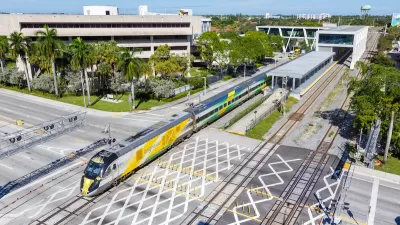Building more high-speed passenger rail in the United States could have significant economic and environmental impacts, creating jobs and reducing carbon emissions.

A new report from the Mineta Transportation Institute (MTI) calculates the potential economic and environmental benefits of expanding high-speed rail (HSR) in the United States.
According to an article in Mass Transit, these benefits include “job growth and increased economic activity, creation of an entirely new domestic manufacturing base, station area development and improved regional connectivity and reduced greenhouse gas (GHG) emissions and better land use.”
For example, “The California High-Speed Rail Authority (CHSRA) estimates high-speed rail has generated an estimated 74,000 to 80,000 jobs per year, $5.6 billion to $6 billion in labor income and $15 billion to $16 billion in economic output between 2006 and 2022.” The rail manufacturing industry also supports roughly 90,000 U.S. jobs as of 2015.
Expanding HSR could also connect megaregions, create more opportunities for housing and employment, and reduce vehicle miles driven and greenhouse gas emissions. “One study found it would cost an estimated $122-199 billion to provide the equivalent highway and airport capacity that the San Francisco to Los Angeles high-speed rail network would provide.”
FULL STORY: MTI report outlines economic and environmental benefits of high-speed rail in U.S.

Maui's Vacation Rental Debate Turns Ugly
Verbal attacks, misinformation campaigns and fistfights plague a high-stakes debate to convert thousands of vacation rentals into long-term housing.

Planetizen Federal Action Tracker
A weekly monitor of how Trump’s orders and actions are impacting planners and planning in America.

San Francisco Suspends Traffic Calming Amidst Record Deaths
Citing “a challenging fiscal landscape,” the city will cease the program on the heels of 42 traffic deaths, including 24 pedestrians.

Defunct Pittsburgh Power Plant to Become Residential Tower
A decommissioned steam heat plant will be redeveloped into almost 100 affordable housing units.

Trump Prompts Restructuring of Transportation Research Board in “Unprecedented Overreach”
The TRB has eliminated more than half of its committees including those focused on climate, equity, and cities.

Amtrak Rolls Out New Orleans to Alabama “Mardi Gras” Train
The new service will operate morning and evening departures between Mobile and New Orleans.
Urban Design for Planners 1: Software Tools
This six-course series explores essential urban design concepts using open source software and equips planners with the tools they need to participate fully in the urban design process.
Planning for Universal Design
Learn the tools for implementing Universal Design in planning regulations.
Heyer Gruel & Associates PA
JM Goldson LLC
Custer County Colorado
City of Camden Redevelopment Agency
City of Astoria
Transportation Research & Education Center (TREC) at Portland State University
Jefferson Parish Government
Camden Redevelopment Agency
City of Claremont





























